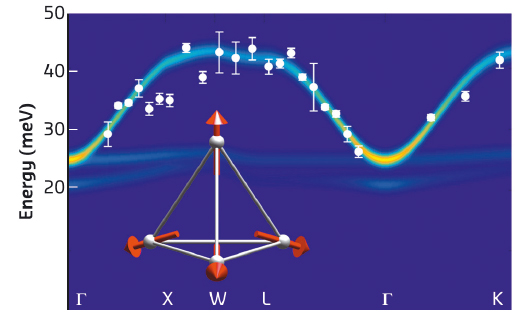- Home
- Users & Science
- Scientific Documentation
- ESRF Highlights
- ESRF Highlights 2016
- Electronic structure, magnetism and dynamics
- When magnetism meets topology
When magnetism meets topology
Sm2Ir2O7 is a prototypical pyrochlore iridate with a finite temperature metal-insulator transition. The nature of its magnetic ground state and low-energy effective Hamiltonian has been revealed using resonant magnetic X-ray scattering. Also, through a combination of elastic and inelastic measurements, the magnetic ground state was established as an all-in all-out (AIAO) antiferromagnet, as required for the realisation of a correlated Weyl semimetal in this class of material.
The search for exotic particles is one of the most fascinating pursuits of modern physics. While this area of research is traditionally associated with elementary particles created in high-energy physics, simple ‘quasi-particles’, with sometimes highly unconventional properties, can also emerge in the complex, many-body world of materials. One such particle is the Weyl fermion. First postulated by Hermann Weyl in 1929 [1], the Weyl fermion is a solution to the Dirac equation of fermion fields that describes a massless fermion with definite handedness. However, no elementary particles that behave as Weyl fermions have yet been observed.
Inside materials, the occurrence of Weyl fermions as quasi-particles hinges on stringent symmetry constraints. Mathematically, the Weyl fermion is described by a two-component spinor, compared to the four-component spinor of Dirac fermions (describing e.g. conventional electrons). Due to the two-component spinor, only two states must meet at the Fermi level of the material. This requires that either time-reversal or inversion symmetry must be broken, to ensure that the touching conduction and valence bands are non-degenerate. Materials hosting Weyl fermions are known as Weyl semimetals. The non-trivial topology of the Weyl points manifests in striking properties, such as Fermi arc surface states, which provide a ‘smoking gun’ experimental signature. In a series of breakthrough experiments in 2015 [2], Weyl semimetals were discovered in a class of materials with broken inversion symmetry.
So far, all Weyl fermions have been found in ‘uncorrelated’ materials, where the electrons only interact weakly with each other. In general, electronic interactions can enrich topological phases. For Weyl semimetals, electronic correlations can stabilise magnetic order, which offers the possibility of a time-reversal symmetry-breaking Weyl semimetal. This correlated Weyl semimetal state is predicted to exhibited yet undiscovered exotic properties, such as the anomalous Hall effect. The most promising candidate materials for this state are iridium-based pyrochlore oxides, known as pyrochlore iridates. While the frustrated pyrochlore lattice hosts many intriguing magnetic states, such as the spin liquids, spin glasses and spin ices, the presence of iridium atoms with strong spin-orbit coupling can induce non-trivial band topology. In pyrochlore iridates, to stabilise a correlated Weyl semimetal state, the microscopic magnetic order has to preserve inversion symmetry. Theoretical studies have identified that the ‘all-in all-out’ magnetic order would fulfil the required symmetries. In this all-in all-out magnetic structure, all the magnetic moments point either towards or away from the centre of the tetrahedra formed by the iridium ions.
We have now discovered that the magnetic moments in pyrochlore iridates do indeed order in the all-in all-out structure. This confirms theoretical predictions and allows the elusive correlated Weyl semimetal state to be realised in these materials. Using resonant X-ray scattering techniques, both the magnetic order and excitations were characterised comprehensively in the prototypical pyrochlore iridate Sm2Ir2O7. By analysing the excitation spectrum, it was possible to deduce the effective Hamiltonian describing this class of material for the first time (Figure 11).
 |
|
Fig. 11: Fitted energy dispersion RIXS scan as a function of momentum transfer and a potential magnetic structure proposed by theoretical calculations. Energy dispersion of magnetic excitations of the all-in all-out magnetic structure (shown in the inset) of Sm2Ir2O7 as a function of momentum transfer, measured by resonant X-ray scattering. |
The experiments were performed at ESRF beamline ID20 (Grenoble, France) and PETRA III (Hamburg, Germany) where the use of state-of-the-art instrumentation was critical; enabling magnetic excitations with a dispersion bandwidth of only 15 meV to be discerned. This presents a remarkable achievement for resonant X-ray scattering.
While our discovery confirms that pyrochlore iridates adopt the required type of magnetic order to host Weyl fermions, the magnetic excitations point towards strong electronic correlations, which may preclude a Weyl semimetal state. In order to achieve a correlated Weyl semimetal state in pyrochlore iridates, the application of internal or external perturbations may therefore be necessary.
Principal publication and authors
All-in–all-out magnetic order and propagating spin waves in Sm2Ir2O7, C. Donnerer (a), M.C. Rahn (b), M. Moretti Sala (c), J.G. Vale (a,d), D. Pincini (a,e), J. Strempfer (f), M. Krisch (c), D. Prabhakaran (b), A.T. Boothroyd (b) and D.F. McMorrow (a), Phys. Rev. Lett. 117, 037201 (2016); doi: 10.1103/PhysRevLett.117.037201.
(a) London Centre for Nanotechnology and Department of Physics and Astronomy, University College London (UK)
(b) Department of Physics, University of Oxford (UK)
(c) ESRF
(d) Laboratory for Quantum Magnetism, Ecole Polytechnique Federale de Lausanne (EPFL) (Switzerland)
(e) Diamond Light Source Ltd, Didcot (UK)
(f) DESY, Hamburg (Germany)
References
[1] H. Weyl, Elektron und gravitation, I. Z. Phys. 56, 330–352 (1929).
[2] Su-Yang Xu et al., Science 349, 613 (2015).



